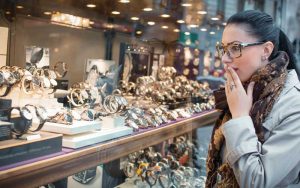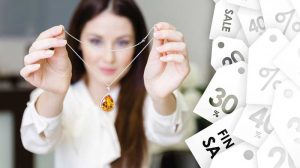The psychology of pricing: How lower prices don’t necessarily mean higher sales volume
by jacquie_dealmeida | May 1, 2016 9:00 am
By Barbara Crowhurst
 Retailers have no control over several major conditions impacting their business. What do I mean by that? Well, consider the economy, weather, area redevelopment, and the competition. The wonderful news is they have full control over managing their own business.
Retailers have no control over several major conditions impacting their business. What do I mean by that? Well, consider the economy, weather, area redevelopment, and the competition. The wonderful news is they have full control over managing their own business.
There are two typical business goals retailers should keep their eye on. I’m referring to increasing foot traffic and growing sales. The 80/20 scenario applies nicely to today’s jewellery retail business, meaning 80 per cent of sales come from 20 per cent of the customer base. What this boils down to is independent retailers are clearly in the ‘relationship retail business,’ building their customer base one interaction at a time.
There are many considerations influencing the purchase of luxury goods. One of them is pricing and it happens to be a factor over which retailers have some control, save for those brands that dictate prices to maintain consistency across their various points of sale (e.g. e-commerce and concept stores).
A numbers game

A great place to start growing foot traffic and sales is to look at the psychology of pricing and what that really means. Pricing psychology refers to human beings reacting to numbers emotionally (i.e. what it feels like), rather than in a mathematical and rational way. It uses the customer’s emotional response to encourage sales. There has been considerable debate as to whether applying pricing strategies actually affect the way consumers purchase; however, the majority of studies agree that when applied correctly, they can indeed be effective. In fact, by pricing products strategically, a retailer can increase sales without significantly reducing prices. And in some cases, a higher price is actually more likely to increase sales.
Jewellery retailers can relate to the idea of ‘sticker shock.’ No matter what a client’s budget, the first time they see a price that is higher than they imagined, they experience sticker shock. This feeling usually goes away as the retailer shares information about the product, pointing out its features and benefits while showing other items with different prices and how they compare.”ƒ
The next area to explore is how a retailer should set prices. Benchmarking prices refers simply to doubling the cost. The traditional term for this is ‘keystoning’ and it implies a 50 per cent markup. Most retailers know this pricing strategy and use it, but I do not recommend it in all cases. Why is that? Products that are in high demand may actually have a higher perceived value, which means a retailer can usually price items higher than keystone. Consider various strategies when marking your products either up or down. Sometimes, it is not in your best interest to take an across-the-board approach and use the keystone method. At minimum, cover your shipping and handling expenses by multiplying the product’s cost by at least 2.4 per cent.
If it’s expensive, it must be good

How do you price product? Are you more of a traditionalist, ending prices with numbers like ‘5,’ ‘7,’ or ‘9.’ From what I’ve observed, there is a movement to price products ending with ‘.00’ or showing it simply as the whole number. For instance, $19.99 is rounded up to $20. For products that end in $6 or $8, or put another way, $56 or $58, consider raising them to the next $10. So that’s $60 in both cases. Studies show people like to think in fives. As such, when an item costs more than $100, look to increase the price to the next $25. In other words, consider raising the price of a $100 item to $125.
Let’s continue with this idea that retail is a numbers game; I recommend testing a few different pricing strategies, especially when putting a product in your showcase for the first time. Here are two to consider:
Add a few dollars to every product you carry. This can really make a difference, particularly when it comes to your best-selling items. If you can’t change certain product pricing because it needs to be competitive, test this idea with the more exclusive products you sell.
Perceived value pricing. This strategy starts the moment you place an order with a supplier. Ask yourself at what price you could sell a particular item. Think outside the very controlling strategy of keystone pricing, and for that matter, the manufacturer’s suggested retail price. You are best at knowing your market, which includes your customers and their tolerance for pricing. You also know what your competition carries and at what price they sell their products.
Is a lower price the best option
to increase sales?

There are two trains of thought as to when a price should be lowered. One is to try to increase demand and the other is to beat out the competition. Both have their own dynamics. However, keep in mind there is a very fine line between lowering a price too much and not enough on a highly competitive brand or item. For instance, if you do not cut the price enough, there could be no change in demand and your profits will decrease. For this strategy to work, you need to test various prices to see what the response is from your customers. On a fundamental level, price is how your clients value your product or service. Customers are willing to pay more for something they really want or when the product is of a certain quality. By changing the price, you may affect the perceived worth of your product or service, leaving your customers to wonder whether the quality or the service is inferior. I recommend an assorted product selection and varied price range. This strategy can help appeal to a wider customer base.
The majority of consumers want brands, designs, selection, good service, and most of all, expertise. A retailer knows what their client base is willing to pay for a piece of jewellery or a watch by studying the sales numbers. They see what’s selling and what’s not, and know what the average sale is in specific categories. Tracking the pricing strategies that work for you is critical, as is testing them. Keeping an eye on the products your competitors carry is also vital to ensuring that where there is overlap, your store comes out on top.
I’ll leave you with a final thought, which happens to be Steve Jobs’ pricing strategy:
1) Offer a small number of products.
2) Focus on high-end products and consumers.
3) Give priority to profits over market share.
4) Create a halo effect that makes people starve for new products.
I think we can learn a lot from Steve. Take what he shares to heart. The whole mechanism of buying and selling provides the operating cash you need to pay for inventory, cover your costs, and if you are doing things right most of the time, will give you what every retailer strives for: profit.
Barbara Crowhurst is a leading retail business coach and CEO of Retail Makeover. She is also a writer, international speaker, trainer, and retail store designer. Crowhurst’s comprehensive and detailed approach to retail comes from years of experience. Her career has taken her from working with some of the largest corporate retail stores in North America to consulting with thousands of independent retail specialty stores. Crowhurst can be reached via e-mail at retailmakeoverca@gmail.com or www.retailmakeover.ca.
Source URL: https://www.jewellerybusiness.com/features/the-psychology-of-pricing-how-lower-prices-dont-necessarily-mean-higher-sales-volume/